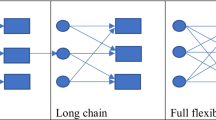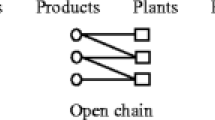Abstract
A major competitive advantage of a flexible manufacturing facility is its ability to cope with uncertainties in demand. At a strategic level, capacity-size decisions for a mix of flexible facilities (each not necessarily producing the same combination of products) are made based on aggregates of product types. Such an approach overlooks possible capacity-devouring by some products, arising at the operational level, when the aggregate demand for the period exceeds the available capacity. A rationing policy is required to ensure that the available aggregate capacity of the facilities is shared equitably. In this article, it is shown that such a rationing policy has an impact on the required capacity size and, therefore, must be integrated with the decisions at the strategic level. Several properties indicating the relative preferences of certain facility strategies are also established.
Similar content being viewed by others
References
Baker,K.R., Magazine, M.J., and Nuttle, H., “The Effect of Commonality on Safety Stook in a Simple Inventory Model”, Management Science, Vol. 32, No. 8, pp 982–988 (1986).
Chakravarty, A.K., “Decision Rules for Switching Flexible Capacity Between Competing Products”, School of Business Administration, University of Wisconsin-Milwaukee (1986).
Chakravarty, A.K., and Gerwin, D., “Economies of Scope and Scale in Manufacturing Facilities Decisions”, School of Business Administration, University of Wisconsin-Milwaukee (1986).
Fine, C.H., and Freund, R.M., “Economic Analysis of Product-Flexible Manufacturing System Investment Decisions”, in Proceedings of the Second ORSA/TIMS Conference on Flexible Manufacturing Systems, K.E., Stecke and R., Suri (Eds.), Elsevier Science Publishers B.V., Amsterdam (1986).
Gerchak, Y., Magazine, M.J., and Gamble, A.B., “Component Commonality With Service Level Requirements”, Management Science, Vol. 34, No. 6, pp 753–760 (1986).
Hayes, R.H., and Wheelwright, S.C. Restoring Our Competitive Edge: Competing Through Manufacturing. John Wiley and Sons. New York, Chapter 4.
Luss, Hannan. “Operations Research and Capacity Expansion Problems”, Operations Research, Vol. 30, No. 5, pp 907–947 (1982).
Phillips, D.T., Ravindran, A., and Solberg, J., Operations Research Principles and Practice, John Wiley and Sons, New York, pp 521–526 (1976).
Talaysum, A.T., Hassan, M.Z., and Goldhar, J.D., “Scale vs. Scope Considerations in the CIM/FMS Factory”, in Flexible Manufacturing Systems: Methods and Studies, A., Kusiak (Ed.), North-Holland, Amsterdam, pp 45–58 (1986).
Author information
Authors and Affiliations
Rights and permissions
About this article
Cite this article
Chakravarty, A.K. Analysis of flexibility with rationing for a mix of manufacturing facilities. Int J Flex Manuf Syst 2, 43–62 (1989). https://doi.org/10.1007/BF00227797
Issue Date:
DOI: https://doi.org/10.1007/BF00227797




